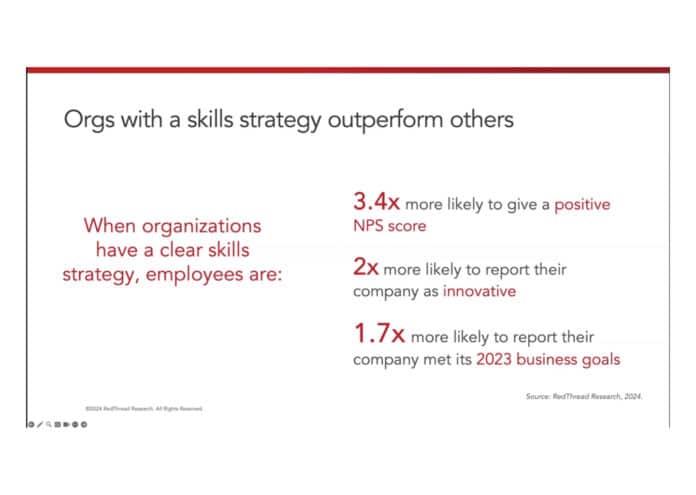“Skills is a movement,” RedThread Research co-founder and principal analyst Dani Johnson said at this week’s HR Tech Online. It’s a movement that’s gained significant traction in the last few years—but many organizations are still sorely lacking a skills strategy.
According to RedThread’s recent survey of 200 business leaders, 94% are thinking about skills to some extent—more than a quarter of them are “significantly” focused on finding and developing the skills their organizations need for the future. However, 43% of those companies lack any skills strategy at all; only 18% have a unified skills strategy across the organization.
Yet, the ROI of a clear skills strategy is evident: According to RedThread’s research, at organizations with a formal skills strategy, employees are 3.4 times more likely than others to rate their employer with a positive NPS, twice as likely to say their company is innovative and 1.7 times more likely to report that their organization met its 2023 business goals.

With outcomes like that, why aren’t more organizations leaning into a skills strategy? Such a shift, Johnson said, requires different ways of thinking, more sophisticated data rigor, new technology, increased levels of collaboration and “relentless focus,” among other challenges.
However, these are chasms that can be addressed, in part, by the learning and development unit taking more of a leadership role in the organization’s skills journey, Johnson said.
L&D’s value to a skills strategy
In a recent RedThread roundtable with L&D leaders, Johnson said, the participants together developed a purpose statement for L&D: “It’s our job to make sure that the people in the organizations we work with have the skills they need to drive the business strategy forward.”
That the word “skills” is embedded in this purpose statement highlights where L&D’s future focus should be, she said.
“Think about how much that [purpose statement] simplifies the noise we hear and that we sometimes feed into—and the new, shiny things that can sometimes creep in,” she said. “It makes it clear and crisp what we’re trying to do.”
Several factors make L&D a catalyst for skills strategy success. For one, the L&D team often generates data about employee skills more quickly than other segments of HR. For instance, the skills data the talent acquisition team gathers largely represents a snapshot from when an employee joins the organization, while the performance management team owns data that’s often generated just once a year. L&D, however, has a view into employee skills each time they complete a course, finish a gig on a talent marketplace or express interest in learning something.
L&D also has broader interaction with employees than other HR professionals—and an inherent responsibility to upskill employees, Johnson added. Technology that would underpin a skills strategy is also flourishing in L&D—starting with basic functionality like learning content being able to be tagged with skills and progressing into coding technologies.

Why L&D should care about skills
While most organizations still have work to do to get a skills strategy off the ground, those that are further along that path are seeing significant “promise,” said Johnson, offering eight reasons L&D teams should prioritize the development of a skills strategy:
- Better HR alignment: Organizations increasingly see skills as a way to communicate their people strategies in a universal language—across performance, talent acquisition, mobility and other HR teams. L&D is often siloed from these functions, but an emphasis on skills can create more alignment, Johnson said.
- Common language for technology: Often, HR may have a handful of different pieces of technology generating data about skills, but they are doing so with inconsistent language, what Johnson called a “huge hangup” that HR and tech leaders are just now starting to address effectively.
- Transparency for employees: When leadership makes skills data available to employees, they can understand how they compare to people on their teams, the skills they need to get to their next role or what they need to develop to move throughout the organization.
- Equity in employment opportunities: Rather than employees being promoted or given a new opportunity at the recommendation of a manager or peer—a highly subjective and potentially bias-filled approach—leveraging skills data can create more equity in hiring and advancement.
- More L&D credibility: All business units want more visibility with senior leadership, and L&D—which Johnson said is typically “notorious for wanting a seat at the table”—can achieve it by driving forward a skills strategy steeped in data-driven insights.
- Better decision-making: Better data leads to better decisions, and a skills strategy can highlight where leaders should invest resources in the talent journey.
- Mass personalization of learning: The concept of personalization in L&D has been talked about for years—for instance, in terms of training by role or persona, Johnson said. With more robust data about the skills employees have, and those they will need, L&D can bring a degree of “mass personalization” to its work. “That skills data, and the mindset associated, will get us to an opportunity where we can provide what [learning] a person needs when they need it rather than assuming we know what they need,” she said.
- It’s “what’s next”: Organizations that want to stay on the leading edge with their people practices, Johnson said, are recognizing the value of a skills strategy. “In the last couple of months,” she said, “we’ve heard the rhetoric around skills change a bit; it’s not just about being a skills-based organization. Now it’s much more about ‘This is just how we’re going to do it. We have access to this granular data, and we can solve some of the problems that we’ve had before if we can use that granular data.’ ”



